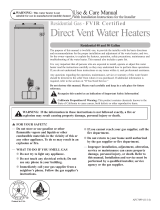
12
The flue collar relief opening of the water heater and combustion air inlet must be in the same atmospheric
pressure zone. Large exhaust fans in kitchens and other locations can lower the air pressure inside an
enclosure and interfere with the proper operation and venting of the water heater. In these cases, the water
heater should be installed in a separate room with the combustion and ventilation air supplied directly from
Unconfined Space
1. In buildings of conventional frame, brick, or stone construction, unconfined spaces may provide adequate
air for combustion and ventilation.
2. If the unconfined space is within a building of tight construction (buildings using the following construction:
weather stripping, heavy insulation, caulking, vapor barrier, etc.), air for combustion and ventilation must
be obtained from outdoors. This may be accomplished by piping air directly to the water heater from
outside or providing opening or ducts in the wall. The installation instructions for confined spaces in tightly
constructed buildings must be followed to ensure adequate air supply.
Confined Space (Spaces having less than 50 ft
3
/1000 BTU/hr (4.8 m
3
/kW))
1. When drawing combustion air from inside a conventionally constructed building to a confined space, such
a space shall be provided with two permanent openings.
The top opening is to be located within 12 in (30 cm) of the enclosure top and the bottom opening
within 12 in (30 cm) of the enclosure bottom.
Each opening shall have a free area of at least 1 in
2
/1000 BTU/hr (2200 mm
2
/kW) of the total input of
all appliances in the enclosure, but not less than 100 in
2
.
2. If the confined space is within a building of tight construction, air for combustion and ventilation must be
obtained from outdoors. This may be accomplished by piping air directly to the water heater from outside
or providing opening or ducts in the wall. When directly communicating with the outdoors through vertical
ducts, two permanent openings, located in the above manner, shall be provided.
Each opening shall have a free area of not less than 1 in
2
/4000 BTU/hr (550 mm
2
/kW) of the total
input of all appliances in the enclosure.
If horizontal ducts are used, each opening shall have a free area of not less than 1 in
2
/2000 BTU/hr
(1100 mm
2
/kW) of the total input of all appliances in the enclosure.
3. If the water heater is installed as a direct vent (outside air piped directly to the water heater), then
additional openings, other than the opening for the air intake, are not required. However, adequate
ventilation air must be provided in all cases to prevent increased room temperature.
All Air From Inside The Building
The confined space must be provided with two permanent openings communicating directly with an additional
room(s) of sufficient volume so that the combined volume of all spaces meets the criteria for an unconfined
space. The total input of all gas utilization equipment installed in the combined space must be considered in
making this determination. Each opening must have a minimum free area of 1 in.
2
/1000 BTU (2.54cm
2
/0.29kW)
per hour of the total input rating of all gas utilization equipment in the confined space, but not less than 100
square inches (254cm
2
). One opening must be within 12 in (30 cm) of the top and one within 12 in (30 cm) of
the bottom of the enclosure.
Specially Engineered Installations
The requirements noted under Confined Spaces above must not necessarily govern when special engineering,
approved by the authority having jurisdiction, provides an adequate supply of air for combustion, ventilation,
and dilution of flue gases.
Chemical Vapor Corrosion
Corrosion of the flue ways and vent system will occur if air for combustion contains certain chemical vapors.
Such corrosion may result in poor combustion and create a risk of asphyxiation, as well as reducing the life
of the water heater. Spray can propellants, cleaning solvents, refrigerator and air conditioning refrigerants,
swimming pool chemicals, calcium and sodium chloride, waxes and process chemicals are corrosive.
Products of this sort should NOT be stored near the water heater or outside by the air intake (if applicable).






















